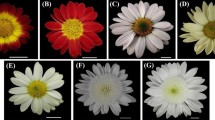Abstract
The single-head cut-flower chrysanthemum is one of the most important and popular varieties of Chinese export cut flowers, but the less collateral varieties are very rare in the market. To produce new, high-quality varieties, we generated two hybrid combinations from the varieties Fukashi (SZ), Jinba (SM), and FengWofen (FW; “SM × SZ” and “SZ × FW”, respectively). A detailed analysis of morphological tests revealed the heredity and variation in the F1 populations. Hybrid plant height showed significant negative heterosis. Flower diameter and the number of small flowers were both diminished, but the ornamental traits of the population overall showed wide variation. The results provided a basis of genetic differences for subsequent analysis. In both crosses, Fukashi played an important regulatory role in determining branching traits in the middle zone and basal zone of the progeny plants: it reduced hybrid branching traits in the middle zone to a certain extent, however, it increased those in the basal zone and there were some transgressive progeny. These results indicate that hybridization is an effective way to contribute to the phenotypic variation of cut-flower chrysanthemums. The inheritance of branching traits identified in this study will be important in improving the plant architecture of chrysanthemum cultivars.




Similar content being viewed by others
References
Beveridge CA (2006) Axillary bud outgrowth: sending a message. Curr Opin Plant Biol 9:35–40
Chen XL, Zhou XY, Xi L, Li JX, Zhao RY, Ma N, Zhao LJ (2013) Roles of DgBRC1 in regulation of lateral branching in chrysanthemum (Dendranthema × grandiflora cv. Jinba). PLoS ONE 8(4):e61717
Cheng X, Chen SM, Chen FD, Fang WM, Deng YM, She LF (2010) Interspecific hybrids between Dendranthema morifolium (Ramat.) Kitamura and D. nankingense (Nakai) Tzvel. achieved using ovary rescue and their cold tolerance characteristics. Euphytica 172:101–108
Dabbert T, Okagaki RJ, Cho S, Boddu J, Muehlbauer GJ (2009) The genetics of barley low-tillering mutants: absent lower laterals (als). Theor Appl Genet 118:1351–1360
Furones-Pérez P, Fernández-López J (2009) Usefulness of 13 morphological and phenological characteristics of sweet chestnut (Castanea sativa Mill.) for use in the DUS test. Euphytica 167:1–21
Huh YJ, Lim JH, Park SK, Choi SR, Kim SH, Pak CH (2011) Endogenous indole-3-acetic acid and trans-zeatin ribosides in relation to axillary bud formation in standard chrysanthemum. Hortic Environ Biotechnol 52:128–132
Immadi S, Patil S, Maralappanavar M, Sajjanar G (2014) Penetrance, expressivity and inheritance of axillary branching in somaclonal mutant of sorghum (Sorghum bicolour L.). Euphytica 196:449–457
Jiang BB, Miao HB, Chen SM, Zhang SM, Chen FD, Fang WM (2010) The Lateral Suppressor-Like gene, DgLsL, alternated the axillary branching in transgenic chrysanthemum (Chrysanthemum × morifolium) by modulating IAA and GA content. Plant Mol Biol 28:144–151
Leduc N, Roman H, Barbier F, Péron T, Huché-Thélier L, Lothier J, Demotes-Mainard S, Sakr S (2014) Light signaling in bud outgrowth and branching in plants. Plants 3:223–250
Li B, Wu R (1997) Heterosis and genotype × environment interactions of juvenile aspens in two contrasting sites. Can J For Res 27:1525–1537
Liang JL, Zhao LJ, Challis R, Leyser O (2010) Strigolactone regulation of shoot branching in chrysanthemum (Dendranthema grandiflorum). J Exp Bot 61:3069–3078
Liu WX, Hou AF, Peffley EB, Auld DL, Powell RJ (2006) The inheritance of a basal branching type in guar. Euphytica 151:303–309
Maralappanavar SM, Kuruvinashetti S, Chandrashekhar CH (2000) Regeneration, establishment and evaluation of somaclones in Sorghum bicolour (L.) Moench. Euphytica 115:173–180
Sun CQ, Chen FD, Teng NJ, Liu ZL, Fang WM, Hou XL (2010) Interspecific hybrids between Chrysanthemum grandiflorum (Ramat.) Kitamura and C. indicum (L.) Des Moul. and their drought tolerance evaluation. Euphytica 174:51–60
Tang FP, Chen FD, Chen SM, Teng NJ, Fang WM (2009) Intergeneric hybridization and relationship of genera within the tribe Anthemideae Cass. (I. Dendranthema crassum (kitam.) kitam. × Crossostephium chinense (L.) Makino). Euphytica 169:133–140
UPOV (1989) Guidelines for the conduct of tests for distinctness, homogeneity and stability. Chrysanthemumspec. In: TG/26/4 (ed) International union for the protection of new varieties of plants
Van Minnebruggen A, Cnops G, Saracutu O, Goormachtig S, Van Bockstaele E, Roldán-Ruiz I, Rohde A (2013) Processes underlying branching differences in fodder crops. Euphytica 195:301–313
Zhu WY, Jiang JF, Chen SM, Wang L, Xu LL, Wang HB, Li PL, Guan ZY, Chen FD (2013) Intergeneric hybrid between Chrysanthemum × morifolium and Artemisia japonica achieved via embryo rescue shows salt tolerance. Euphytica 191:109–119
Acknowledgments
This work was supported by the 863 project of the Ministry of Science and Technology of the People’s Republic of China (2011AA100208), and the National 948 Key Project of Ministry of Agriculture (Grant No. 2011-G17).
Conflict of interest
The authors declare that they have no conflict of interest.
Author information
Authors and Affiliations
Corresponding author
Rights and permissions
About this article
Cite this article
Yang, Y., Wen, C., Ma, N. et al. Heterosis and genetic analysis of branching in cut-flower chrysanthemums. Euphytica 205, 915–925 (2015). https://doi.org/10.1007/s10681-015-1439-7
Received:
Accepted:
Published:
Issue Date:
DOI: https://doi.org/10.1007/s10681-015-1439-7




